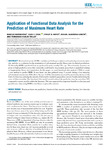Mostrar o rexistro simple do ítem
Application of Functional Data Analysis for the Prediction of Maximum Heart Rate
| dc.contributor.author | Matabuena, Marcos | |
| dc.contributor.author | Vidal, Juan C. | |
| dc.contributor.author | Hayes, Philip R. | |
| dc.contributor.author | Saavedra-García, Miguel A. | |
| dc.contributor.author | Huelin Trillo, Fernando | |
| dc.date.accessioned | 2020-02-10T19:46:16Z | |
| dc.date.available | 2020-02-10T19:46:16Z | |
| dc.date.issued | 2019-08-29 | |
| dc.identifier.issn | 2169-3536 | |
| dc.identifier.uri | http://hdl.handle.net/2183/24878 | |
| dc.description.abstract | [Abstract]: Maximum heart rate (MHR) is widely used in the prescription and monitoring of exercise intensity, and also as a criterion for the termination of sub-maximal aerobic _tness tests in clinical populations. Traditionally, MHR is predicted from an age-based formula, usually 220-age. These formulae, however, are prone to high predictive errors that potentially could lead to inaccurately prescribed or quanti_ed training or inappropriate _tness test termination. In this paper, we used functional data analysis (FDA) to create a new method to predict MHR. It uses heart rate data gathered every 5 seconds during a low intensity, sub-maximal exercise test. FDA allows the use of all the information recorded by monitoring devices in the form of a function, reducing the amount of information needed to generalize a model, besides minimizing the curse of dimensionality. The functional data model created reduced the predictive error by more than 50% compared to current models within the literature. This new approach has important bene_ts to clinicians and practitioners when using MHR to test _tness or prescribe exercise. | es_ES |
| dc.description.sponsorship | Ministerio de Economía y Competitividad; TIN2015-73566-JIN | es_ES |
| dc.description.sponsorship | Xunta de Galicia; ED431G/08 | es_ES |
| dc.description.sponsorship | Xunta de Galicia; GRC2014/030 | es_ES |
| dc.language.iso | eng | es_ES |
| dc.publisher | IEEE-Institute of Electrical and Electronics Engineers | es_ES |
| dc.relation.uri | https://doi.org/10.1109/ACCESS.2019.2938466 | es_ES |
| dc.rights | Atribución 3.0 España | es_ES |
| dc.rights.uri | http://creativecommons.org/licenses/by/3.0/es/ | * |
| dc.subject | Maximum heart rate prediction | es_ES |
| dc.subject | Functional data analysis | es_ES |
| dc.subject | Machine learning | es_ES |
| dc.subject | Low intensity sub-maximal test. | es_ES |
| dc.subject | Predicción de frencuencia cardíaca máxima | es_ES |
| dc.subject | Análisis de datos funcionales | es_ES |
| dc.subject | Aprendizaje automático | es_ES |
| dc.subject | Intensidad baja prueba submáxima | es_ES |
| dc.title | Application of Functional Data Analysis for the Prediction of Maximum Heart Rate | es_ES |
| dc.type | info:eu-repo/semantics/article | es_ES |
| dc.rights.access | info:eu-repo/semantics/openAccess | es_ES |
| UDC.journalTitle | IEEE Access: The Multidisciplinary Open Access Journa | es_ES |
| UDC.volume | 7 | es_ES |
| UDC.startPage | 121841 | es_ES |
| UDC.endPage | 121852 | es_ES |
Ficheiros no ítem
Este ítem aparece na(s) seguinte(s) colección(s)
-
GI-INCIDE - Artigos [17]






